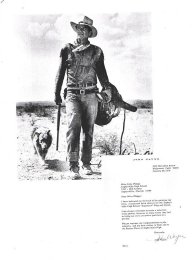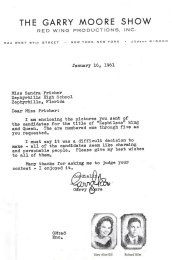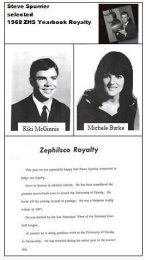HISTORY OF ZEPHYRHILLS HIGH SCHOOLThe Decade of the 1960s at ZHSAt ZHS during this decade there is a great deal of normalcy and the impact of change facing the country is gaining some early momentum in this little bedroom community that remained traditional, conservative and protected from most of the traumatic change impacting the country. As the historian looks back through the notes and archives of ZHS in the 1960s, there was a quiet innocence there. The social impact and cultural change of the 1960s appeared to embrace ZHS more in the decade of the 1970s. There were however, some hints of change. The dramatic events of this ZHS decade included: several phenomenal ZHS state basketball championships in rapid succession, the dawning of the first indoor ZHS gymnasium, christened in 1967; an unprecedented Teacher’s Strike that impacted the school, and two particularly influential school principals who shaped the school. Basketball was the pride of ZHS throughout the decade of the 1960’s! Champs in 1960 were Norman Weaver, J.W. Wells, Clayton Stokes, Mike McGinnis, Woody Cone, Larry Benjamin, Clyde Bracknell, Sam Gross, Frank Kearse and Coach Jack Wilson. The 1960-61 ZHS Basketball team set 10 new school records and seven individual marks that stayed in the books for a long time. In 1964, the ZHS bulldogs were featured in a TV interview over WEDU Channel 3 and escorted to Tampa by the School Superintendent Chester W. Taylor for the spectacular program on the team—they were the Varsity State Champions, coached by Coach Charles McKinney, ZHS Athletic Director. Perhaps the best summary of the decade’s basketball success is summarized by alumni, Jerry Pricher on his website which capsulizes—Jerry Pricher, the President of the ZHS Student Council in 1969 (who later served as a Zephyrhills teacher for 30 years, said the following about the timeframe)—
Listen if you will to the sportscasters of the day as they reported with pride on the phenomenal state championship teams, for example:
ZHS also had its own Billy The Kid. Billy McGavern was quite a star…in the February 1961 game with Tampa’s King in a score of 76-34. The News reported…
Basketball permeated the school culture and spilled over into other institutions. The “Basketball Victory Hop” was popular in 1961. Also in sports history, ZHS brought home the State Baseball Championship again in 1966. Standouts in regard to school leadership were two principals of long tenure at ZHS. Charles Henderson left ZHS to be the principal at the on-campus school, P.K. Yonge at the University of Florida in 1964 after serving as principal from 1955-57 and again from 1959-1964. He and his successor, shared the distinction as principals of ZHS of having served two terms as principal, not in succession. His successor, Raymond Stewart, came in 1964 from Palmetto High School (with an impressive record as a winning football coach and AP there) and provided strength of leadership that was particularly needed during the late 60s and turbulent 1970s for ZHS. Other significant leaders in education for ZHS during the 1960s included Margaritta C. Witt, who was the Zephyrhills School Board member for 19 years (4 terms)and retired in 1968; as a Zephyrhills resident, she believed it her mission to advocate for ZHS. In 1960, I.A. Krusen had already served 20 years as Chairman of the Pasco County School Trustees. At the 1963 graduation, Principal Henderson paid tribute to Mr.Krusen, pointing out that Mr.Krusen had given diplomas to 23 of the last 24 graduating classes (Mr. Krusen was convalescing from a heart attack he suffered the December before and the students gave Mr. Krusen a standing ovation.) Social strife was evident and students were aware of the brewing community issues. Just prior to the integration of the schools in 1970, Daniel Pollock, the ZHS Valedictorian of 1968, delivered one of the most eloquent of Valedictorian speeches and discussed a myriad of societal issues. Perhaps most poignant were his open comments about racial issues in his graduations speech:
Another turbulent issue was the Teacher Strike in 1968. Nineteen of the ZHS faculty members walked out in the FEA-induced teacher walk-out and the state legislature and Governor Kirk, fully supported by the Pasco School Superintendent, Chester Taylor, took a hard line approach on their action—declaring it “totally unacceptable,” and revoked their tenure in some cases. At the high school, Eugenia Moshonas, guidance counselor, and James Davis, math teacher came back to honor their contracts while the resignations of six others were accepted. A byproduct was the closing of school for a few days and a plea to the community for certified volunteers to fill in. Mr. Taylor said, “if you have a college degree or some college training in the correct field…you are needed and will be paid $26 per day for your services.” Popular 60’s culture was evident. At the high school Class Nite celebration in 1968, take offs of the “Smother’s Brothers and Rowan and Martin Laugh In” were featured. And just like the movies and TV of the day, they also were censored: Jannette Dunnigan reports in her School Daze column of 1968, “Would you believe—class night was a success? Of course, it was even though all the censors, we still came out a pretty decent Class Night Program. I hope there weren’t too many hard feelings for you Juniors.” It seemed to be a combination of the Smothers Brothers Show and Rowan and Martin Laugh In, two popular television series with our generation. The school news of the decade does hint at the Vietnam war. Technology had truly come of age at ZHS. An AV (audiovisual) supply fee of fifty cents was charged in 1962 and the sports games were broadcast on the local radio station. Filming of the games even took place in 1968. “All home games of the Zephyrhills football team will be filmed this fall, thanks to a contribution voted Monday night by the Quarterback Club at the year’s first organizational meeting.” –September 5, 1968. The FHA club in May of 1969 had as one of their service projects the collection of articles for the American soldiers serving in Vietnam. “Anyone wishing to donate small, useful articles is asked to bring them to either the home economics building or the main office.” The popular culture also influenced the Zephilsco (yearbook). Throughout the 1960s, key television celebrities worked with the yearbook vendor to select the coveted ZHS Yearbook King and Queen from among photographs that were sent to them of the nominees. Consider that the following celebrities were selected the yearbook king and queen:
Perhaps from this era of drama, one particular ZHS student, Judy Goulding who held the title of Miss Zephyrhills, became a novelist and used the pen name of Ashley Chapel, publishing several books. She was on student, X.L. Garrison’s committee for the 1962 prom decorations and served as Girls State delegate…looking back, one wonders if she wasn’t developing some fodder for her later romance novels, “Sweet Savage” and “Kiss of Satin,” published by McFadden Books and Dell Books. In the area of curriculum, vocational courses were increasing. At the ZHS DCT banquet in May of 1964, the community was represented by some 21 area Zephyrhills employers who were involved in the vocational educational program…Back Construction Company, Thriftway, Paul’s Richfield Station, Raymond’s Body Shop and many more. A particular standout was the Florida Power company which is mentioned again and again during the decade as the host of events and the facilitator of the Florida Power Writing Contest. ZHS’ first exchange student, Lillian Daccarett from Santiago, Chile, was involved in the school in January of 1963. Perhaps most noteworthy in regard to changes in academics, was the opening of a separate –Zephyrhills school the newest since 1910. With an enrollment that was growing, there was a need for a separate elementary school. By enrollment day for the 1968-69 school year, the combined Zephyrhills school enrollment was 1636. To accommodate this growth during the decade, the West Zephyrhills school was opened. Superintendent Chester Taylor dedicated the new school on Zephyrhills Founder’s Day with the ZHS Band Director John T.V. Clark directing a program of music as he opened the 24 classroom building which cost $181,000. The new principal was Arleis Ross who had been an Assistant Principal at ZHS. In regard to music, the ZHS band continued to thrive under the leadership of John T.V. Clark and many awards were documented in the archives. FFA had several musical groups as well. For example in 1964, not only did ….
Plays during the decade included: No Boys Allowed in 1961 and several other comedies. The Safety Patrol played an important role, almost as a type of forerunner to ROTC programs which came in the 1980s, PTA celebrations frequently included ceremonies with involvement of the Florida State Highway Patrol and Pasco County Sheriff Department for the presentation of membership badges and honors to the Safety Patrol members. Clubs of the decade are dominated by FFA, FHA, Student Council and a Youth For Christ Bible Club. A club in 1960 known as Kids Against Cancer with Gary Crist as President and Bonnie Reed as VP, worked “to raise money for research on the cause of cancer and to acquaint students and people in Zephyrhills with the work that is being carried on…” The first graduation in the new gymnasium took place in May of 1967 for a 63-member senior class. The ZHS PTA hosted a spectacular open house at the unveiling of the ZHS gymnasium on January 12, 1967, and allowed parents and community members to tour the locker rooms and complete facility in groups of twenty. There was great pride in the new gymnasium. Graduations continued to be festive events with proms, senior trips and end-of-the year plays that had become traditions. The Prom theme of 1969 took on the Twilight Zone hype with its title, “Outer Limits.” The 1962 prom was held in the Municipal Auditorium which was the case for all of the 1960’s proms. Senior trips took on new looks—in 1963, the seniors voted to do a camping outing to O’Leno State Park near High Springs. The 1962 Senior trip was featured in a magazine cover—the front cover of the March-April Issue of Atlantic Coast Line Railroad News published in Jacksonville featured a giant photo of the Zephyrhills High and Pasco High Seniors of 1962 standing on the front steps of the Capital in Washington, D.C.—the photo was used to illustrate a “sure sign of spring in Washington, D.C.” as a “typical tour group.” (Noteworthy was the combined senior trip from among the two high school rivals, PHS and ZHS). As Zephyrhills Schools embarked upon the second consolidation in 1970 with the integration of students, a review of an important school in the Zephyrhills area is reviewed prior to the year by year analysis of the decade. Teacher/Librarian, Celia Anderson, who was writing a book about education at the time of her death shared the following about that time period in Zephyrhills from her own first-hand experiences. Celia was a ZHS graduate in the 1920s and then taught at ZHS and surrounding schools. Her daughter, Dedi Anderson, shared her writings with the author, and they are printed verbatim:
Photos of the original African-American School in Zephyrhills, which was located on the Krusen property are included as well as a review from information in an interview from community activist/historian, Irene Dobson.          The African American School located at Krusen Quarters included Bessie Barefield, Principal (who also taught grades 1-3) and Martha L. Lewis, teacher of grades 4-6. Books and supplies were limited. A pot-bellied stove provided the heat and wood from the oak and pine trees in the area supplied the fuel. An outdoor privy in a shed provided the bathroom. An outdoor spigot provided water.      The Zephyrhills Depot recognized Bessie Barefield, Principal of the African American School in Zephyrhills in 1949. As Ms. Anderson’s synopsis indicated, most African-American students who attended school prior to integration, traveled to Dade City to attend the Moore Academy or O.K. Mickens High School. Photo at left is of Professor J.D. Moore. In the early days of Dade City, education was limited for blacks. At the turn of the century, if black children attended school at all, it was in classes at local churches. There weren’t any permanent schools for blacks in Pasco County. If you were black, the best you could expect was six months of school. But in the 1900’s a Dade City barber, Arthmus Roberts, initiated the idea of a permanent school for blacks. Roberts, a black man, could hardly read and write, but he realized the importance of education and raised the money to start the first school for blacks. Roberts brought Professor J. D. Moore to Dade City to teach at the school. [The name Arthmus Roberts apparently is incorrect. –jm] Shortly after, Professor O. K. Mickens came to Dade City from Marion County and began teaching as well. He later became principal and named the school Moore Academy, after Professor Moore. In 1939, Professor Moore donated his property to the county for construction of a new school for blacks. The school was built on Whitehouse which is now Whitehouse Ave and the name Moore Academy was retained. The Zephyrhills Depot museum has the following song in its archives: The Integration Song by Nannie H. Borroughs Sing the Wondrous Love of Justice, Sine its mercy and its grace, Let all nations know its power To bring hope to every face. Chorus: 1) When we all know Justice, What a day of rejoicing that will be, When we all have justice, We’ll live in peace and harmony. 2) The world knows the blessed Story, Of the loyalty of the race, How in war gave its devotion To defend Old Glory’s place. 3) Justice is the nation’s promise, It has made in words that burn, Nothing less will save our country, Never from her promise turn. More classrooms for Zephyrhills Needed for Progress in Integration, Zephyrhills News, July 27, 1967 Principals Report 10 Teachers Will Cross Color Line When complete integration of white and Negro children occurs in Pasco County, the bulk of the Negro school population will come to Zephyrhills. At least that will be the case if the neighborhood school concept is carried out, and the bussing of Negro pupils to Dade City school centers is discontinued. Yet Zephyrhills does not now have facilities to accommodate a great influx of additional pupils of whatever race; classroom construction has barely managed to keep pace with normal school growth. For this reason, Pasco County School Board Member, Ted Williams of Land O’ Lakes has expressed hope that when the next school budget is drawn, it will include capital outlay funds to build additional classrooms in Zephyrhills “to keep from transporting Negro children to Dade City,” he said. Department of Health, Education and Welfare officials from Washington, D.C. are urging the closing of Mickens High School in Dade City and the conversion of that plant into another junior high or elementary school to serve the county seat town. Williams has stated that he doesn’t think the school board can educationally or economically explain a high school with only 30 members of the seniors class as was the case at Mickens High School last year. If they could, then Land O’Lakes could qualify for one with a student body of approximately 200 pupils, he said. Faculty Integration–HEW has indicated it demands that at least 34 Negro teachers be integrated into the various schools of the county; the school board has replied that such a figure is impossible—that there are not that many Negro teachers presently. (It is noteworthy that Earnest Abner, Physical Education Teacher and Melvin Dennard, teacher and Assistant Principal at ZHS, and Joyce Snow, Algebra Teacher at ZHS were all individuals that came to the ZHS community through this time frame. ZEPHILSCO ROYALTYIn the 1960s and 1970s, editors of the Zephilsco asked celebrities to select the yearbook King and Queen. Click on an image for a larger picture.
|










